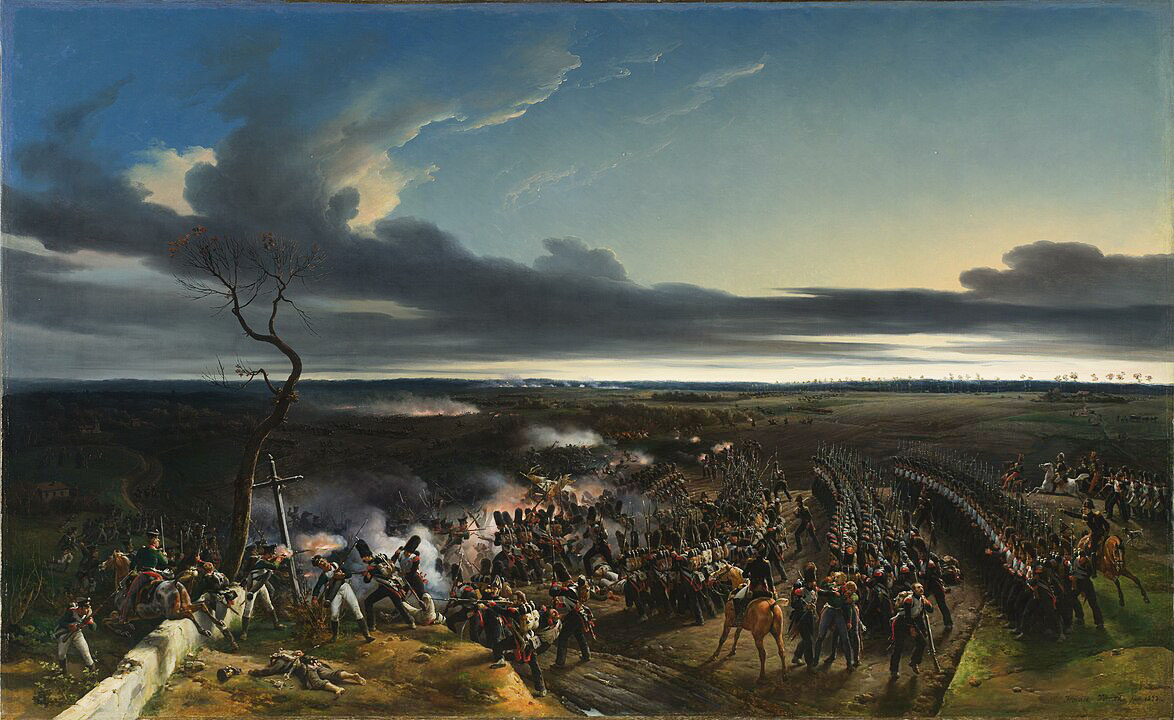
The Battle of Montmirail Painting by Horace Vernet
A Story of Art, War, and National Glory
The painting The Battle of Montmirail by Horace Vernet is a monumental piece of historical art that captures not just the fury and valor of Napoleonic warfare but also the pride of French nationalism during the 19th century. Rich in detail, symbolism, and historical significance, this work is not only a visual chronicle of a pivotal battle but also a vivid example of how art can reflect and shape national identity. This comprehensive analysis will explore the historical context of the painting, its artistic elements, symbolism, and meaning, along with a discussion of the artist and the painting’s current location.
Who Painted The Battle of Montmirail?
The artist behind The Battle of Montmirail is Horace Vernet, a celebrated French painter born in 1789, the same year the French Revolution began. Coming from a family of artists, Vernet was the grandson of Claude Joseph Vernet and son of Carle Vernet, both prominent painters. He gained fame for his historical and military paintings and was favored by the July Monarchy and later Napoleon III.
Vernet was known for his dynamic and realistic depictions of battle scenes, often portraying moments of intense drama and heroism. His background and era placed him in a unique position to document and romanticize France’s military past, particularly the Napoleonic Wars, which had deeply shaped the national consciousness.
What Is The Battle of Montmirail Painting All About?
The painting captures the Battle of Montmirail, fought on February 11, 1814, during the Six Days’ Campaign of the War of the Sixth Coalition. This campaign was one of Napoleon Bonaparte‘s last successful military maneuvers before his fall from power. In this engagement, Napoleon’s forces defeated a larger coalition army composed primarily of Russian and Prussian troops.
Vernet’s painting portrays Napoleon and his elite troops at the height of their tactical brilliance. The Emperor is shown on horseback, composed and commanding amid the chaos of war. The battlefield is alive with motion: soldiers charging, wounded men crying out, flags whipping in the wind, and the smoke of cannon fire thickening the air.
This scene is not just a historical moment, it is a celebration of French tenacity, leadership, and martial excellence. It encapsulates a fleeting yet glorious victory during the waning days of Napoleon’s reign.
Symbolism and Interpretation of the Painting
Horace Vernet’s The Battle of Montmirail is rich in symbolism that goes beyond the mere depiction of a historical battle. Every element, from composition to lighting to the figures represented, serves a symbolic function that aligns with Vernet’s intent to immortalize French heroism.
1. Napoleon as the Heroic Leader
Napoleon is placed prominently in the composition, often illuminated more than those around him. His calm demeanor amid chaos symbolizes not only leadership but almost divine command. This reflects the Romantic-era tendency to elevate national leaders to mythic status.
2. Unity and Diversity of French Forces
Vernet makes a point to include soldiers from different branches of the military, the Imperial Guard, cavalry, infantry, and artillery, working in coordination. This symbolizes the unity and strength of the French nation when under strong leadership.
3. Glory in Sacrifice
The wounded and fallen soldiers are not hidden; rather, they are placed where the viewer can see them, their faces often turned upward in expressions of pain or resolve. This conveys the notion that glory often comes through sacrifice, a common theme in 19th-century military art.
4. Nature and Light
The landscape, while war-torn, is not bleak. Sunlight breaks through the clouds, highlighting key figures and areas, which may symbolize hope and divine favor. The use of light guides the viewer’s eyes toward the heroic elements of the composition.
5. The Tricolor and National Symbols
French flags are prominently displayed, often contrasted with fallen enemy standards. This not only asserts national pride but also the legitimacy of Napoleon’s campaign, despite its historical context as part of his final and ultimately doomed attempt to defend his empire.
Artistic Style and Technique
The Battle of Montmirail is an exemplary piece of Romantic history painting, a genre that flourished in the 19th century. Romanticism in art emphasized emotion, individual heroism, and dramatic narrative, all of which are present in Vernet’s work. However, Vernet’s style also includes elements of Realism, particularly in his attention to accurate military costumes, weapons, and topography.
His brushwork is precise, and the composition is carefully arranged to guide the viewer’s gaze across the canvas in a dynamic but coherent way. The use of color is deliberate, with vibrant reds and blues drawing attention to French soldiers and symbols, while darker, more muted tones characterize the enemy and background chaos.
Vernet was known for his almost cinematic approach to battle scenes, and this painting is no exception. It tells a story not just in a single moment, but across a tableau that suggests movement, cause and effect, and human drama.
What Is Happening in The Battle of Montmirail Painting?
In the painting, Vernet captures the crescendo of the battle, a moment of decisive French charge and command. Napoleon is at the center, surrounded by his aides and officers, issuing orders or surveying the battlefield. In the foreground, French infantry and cavalry engage with coalition forces in close combat.
There are explosions and smoke in the background, indicating artillery fire. Horses rear, soldiers shout and clash with bayonets, and wounded men are tended to or lie motionless. The chaos is palpable, but the composition gives a sense of order through the leadership of Napoleon, who acts as the eye of the storm.
This is not a depiction of the aftermath of war, but of the war in full motion, an homage to military valor at its peak.
What Type of Art Is It?
The Battle of Montmirail is best classified as a Romantic history painting. Within the broader context of art history, it is a military painting that uses the conventions of Romanticism to evoke emotional engagement and national pride.
History painting was considered the highest form of art in the 18th and 19th centuries, often involving large-scale canvases and grand subjects such as mythology, religion, or national history. Vernet’s painting falls firmly into this tradition, with its subject drawn from recent history and treated with grandeur and seriousness.
Moreover, the painting serves propagandistic purposes. Commissioned or supported by regimes seeking to bolster national identity, such artworks were meant to inspire, educate, and unify citizens around a shared historical narrative.
Where Is the The Battle of Montmirail Painting Located Today?
Today, The Battle of Montmirail by Horace Vernet is housed at the Palace of Versailles in France. More specifically, it resides in the Galerie des Batailles (Gallery of Battles), a grand hall within the palace dedicated to monumental paintings depicting French military victories from the Battle of Tolbiac (496 AD) to the Battle of Wagram (1809).
The Galerie des Batailles was created during the reign of King Louis-Philippe in the 1830s as part of his effort to turn Versailles into a museum celebrating all of France’s military glory, regardless of regime. Vernet’s painting fits perfectly within this narrative, aligning with Louis-Philippe’s attempts to unify royalist and Napoleonic factions through shared historical pride.
The Enduring Legacy of Vernet’s Masterpiece
The Battle of Montmirail is more than just a painting of a battle; it is a visual encapsulation of an era’s values, aspirations, and historical consciousness. Horace Vernet, through his skill and perspective, offers us not just an image but a story, one of heroism, nationalism, and the fleeting nature of glory.
In a single frame, Vernet combines the personal with the political, the brutal with the beautiful, and the historical with the symbolic. Whether viewed as a piece of art, a historical document, or a nationalistic emblem, The Battle of Montmirail continues to command attention, provoke thought, and inspire admiration.
Its current home in the Galerie des Batailles only adds to its significance, placing it among the pantheon of artworks that tell the story of a nation through the language of paint, canvas, and unwavering vision.




